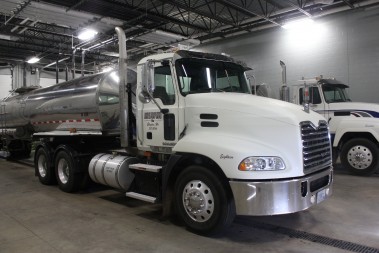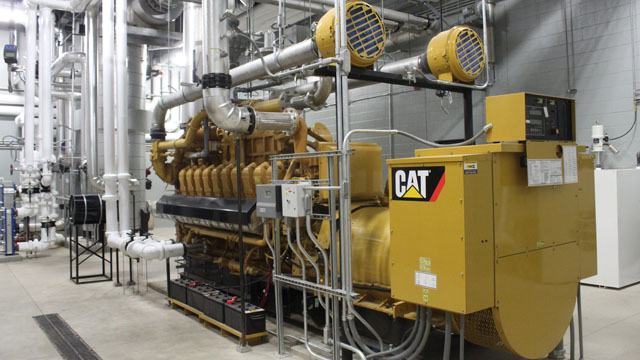Land spreading is tightly regulated by the Wisconsin Department of Natural Resources. The wastewater has high levels of phosphorus and nitrogen that could run off into nearby lakes and streams, causing oxygen depletion and blooms of noxious algae.
In the community of Turtle Lake, a startup company called GreenWhey Energy is using wastewater from Comstock Creamery and other cheese plants to make natural gas, and produce electricity for the local grid, as well as heat. The $30 million construction project, which included green-energy tax credits and loans, wrapped up this spring.
The centerpiece is what’s called an “upflow anearobic digester.” Eric Ludy, a lab technician and son of one of the company’s founders, pointed to a huge concrete wall laced with dozens of large pipes. “The whole plant is built around two two-million gallon reactors,” he said. “So, behind this wall … there’s four million gallons of water.”
That water is filled with anaerobic bacteria that eat the dairy wastewater and produce methane gas. Ludy said the gas is treated and eventually powers two 20-cylinder generators.
“They look like massive locomotive engines and that’s basically what they are,” said Ludy. “They’re powered entirely on biogas, which is a mix of methane and carbon dioxide, trace amounts of other materials like hydrogen sulfide, and they pump out about 3.2 megawatts of electricity.”
Some dairy plants, meat processors, and even breweries have their own biodigesters. In Milwaukee, the Forest County Potawatomi tribe has just started operating a biodigester that's similar to GreenWhey's but smaller. But co-founder Tom Ludy said his is the first privately owned company to contract for multiple sources of food wastes.
“We also do soy waste from soy protein,” said Ludy. “We do mustards and dressings and horseradish waste food products here –-several different ones besides dairy. But dairy is the main one.”
Before Ludy could start GreenWhey, he had to buy his bacteria –- which he calls “bugs” –- in the form of feed sludge from a brewery in La Crosse and a meatpacking plant in Green Bay.
“The secret is, the more you put in to start with, the less time it takes to start,” said Ludy. “So, we hauled in here as much as we could afford and now we are going through our startup process.”
GreenWhey is running at about 50 percent capacity as they wait for their bacteria to reproduce. But they’re already having a big impact on the area. Ludy said they’re keeping hundreds of thousands of gallons of wastewater off the ground every day. He also said testing shows that they’re keeping about 1,000 pounds of phosphorus from getting into rivers and lakes each day.
Looking to the future, Ludy hopes to make and sell excess natural gas, sell heat to nearby cheese plants, and process their leftover sludge to make fertilizer.
As America’s obsession with cheese continues to grow, so do the possibilities of turning leftover waste, once considered a liability, into a valuable commodity.

